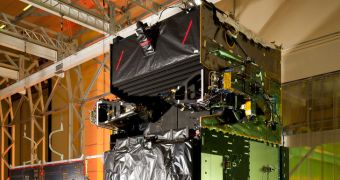The second Space Based Infrared System (SBIRS) geosynchronous (GEO-2) satellite Lockheed Martin is developing for the United States Air Force (USAF) has just completed its thermal vacuum testing. This brings the spacecraft significantly closer to launch.
GEO-2 will aid the US improve its missile defense, technical intelligence and battlespace awareness, while at the same time providing the most advanced early missile-warning system available to date.
In order to ensure that the satellite can withstand the harsh conditions of space, it was subjected to both extremely hot and cold temperatures during its environmental testing phase. Regardless of conditions, its functionality and performance did not waver.
“The GEO-2 team has done a tremendous job in utilizing lessons learned from GEO-1 in order to streamline the GEO-2 test schedule and deliver this essential asset to the user as quickly as possible,” says the SBIRS Engineering and Manufacturing Development program manager, Colonel Troy Brashear.

 14 DAY TRIAL //
14 DAY TRIAL //